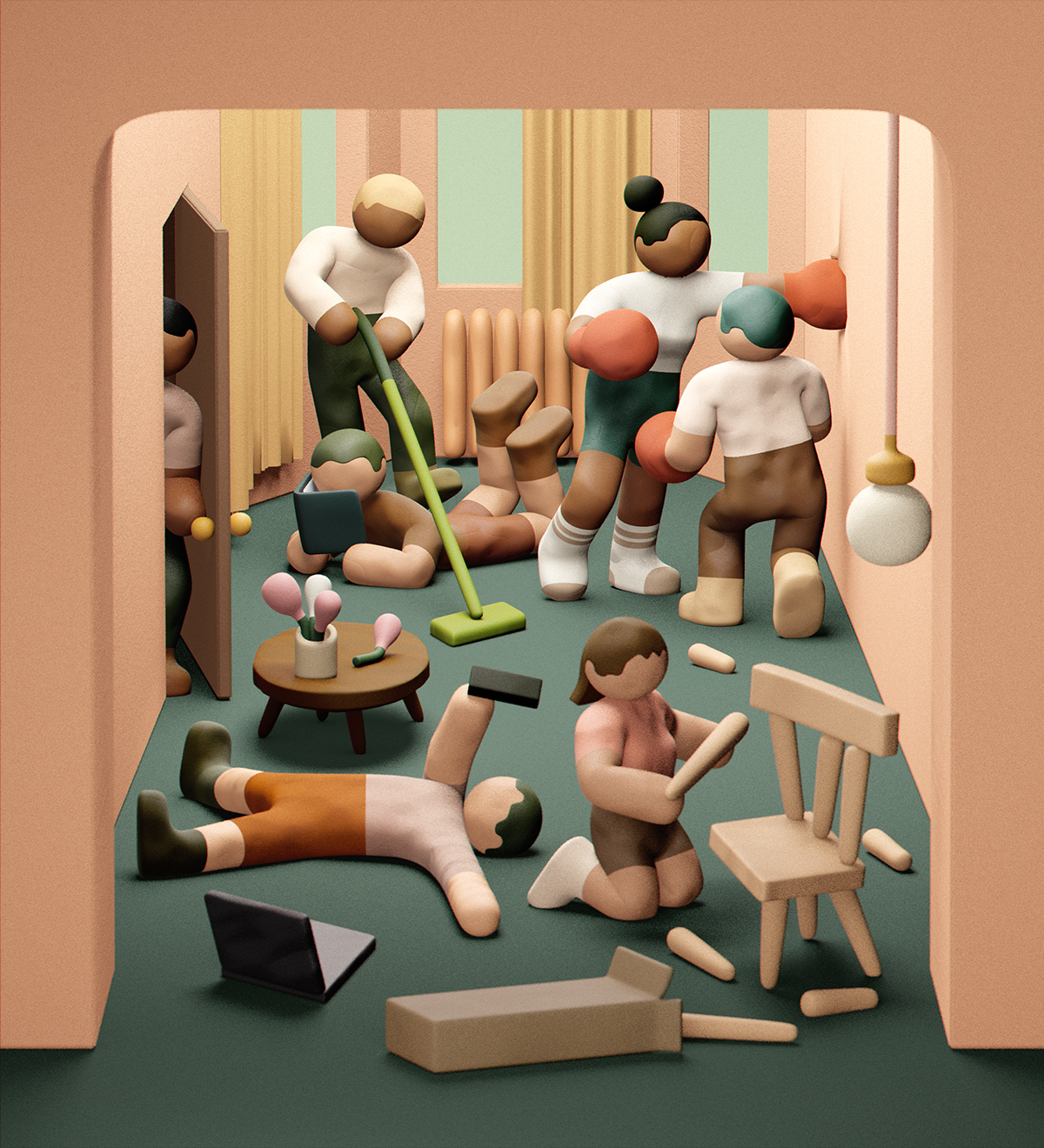In late March, when New York City went into lockdown, I had to make a choice: either I shelter in place with my roommate (who is at higher risk of illness from the virus) and my two cats in our shared Brooklyn apartment, or I relocate to my partner’s one-bedroom space, some fifteen minutes’ walk east, not to return for the indefinite duration of the pandemic. Neither option was ideal. Our apartment had a slightly more centralized location, marginally more space, a dishwasher, and on-site laundry; it also had all of my stuff and the aforementioned cats (to whom my partner is severely, and frustratingly, allergic). On the other hand, my partner’s apartment had, well, my partner. Intimate companionship. The promise of emotional support amid an unprecedented episode of collective crisis. The assurance of human touch amid mounting paranoia over contact and spread. In the simplest possible terms: I could choose home, or I could choose hugs.
I went with the former.
Listen to an audio version of this story
For more audio from The Walrus, subscribe to AMI-audio podcasts on iTunes.
More than half a year later, I don’t regret my decision, though I struggled to explain my almost comically depressing “date night” Instagram photos to colleagues and friends, my partner’s surgical mask providing a pop of blue from some ten feet behind my shoulder. After all, I’m a member of the demographic sweep of city dwellers for whom home ownership has become a fable. The desperate calculus of suboptimal housing prospects is practically our rite. Like many of my peers, I’ve grown resigned to the reality that where I live—and, often, with whom—is subject to the whims of things beyond my control: boomers, feline immunotherapy advancements, and the market’s appraisal of my skill set in a given fiscal quarter. In 2019, I was one of the last of my journalist friends to experience the dreaded but inevitable media-company layoff—along with all of my coworkers. The growing scarcity of jobs in my field coexists with a generational landscape of underemployment and wage stagnation, of less in savings and more in debt.
For those of us born without the superpower of (other people’s) wealth, you might say that this very instability is our own inheritance. What it usually means is getting a roommate.
In the public imagination, the nuclear family still looms large as the de facto template for “home.” But the numbers tell a different story. In 2016, there were roughly 582,000 noncensus family households across Canada—homes of two or more people outside of parent-child or partnered relationships. South of the border, more than one-third of US adults lived in a shared household as of 2017. That figure marks a relatively slight increase over the estimated 28.8 percent of shared households in 1995, a time that boasted two beloved roommate-centric prime-time sitcoms, Living Single and Friends.
What’s different today is the length of time that shared housing factors into the lives of young(ish) adults. In the US, the 2008 recession propelled an adult-roommate boom that never ended—a trend prevalent in cities, where young (and youngish) adults flock for jobs. In Canada, urban co-living startups, like Roost and SoulRooms, echo the broader turn toward “adult dorm” housing setups seen in cities from Dublin to New York.
None of this should come as a surprise. Millennials like me comprise the largest living generation in North America, yet we are grossly underrepresented in the ranks of homeowners in the US and Canada alike. In both countries, a rising proportion of this demographic is delaying marriage or forgoing it completely. It follows, then, that more adults than ever are navigating their path-defining mid-twenties to late thirties untethered to the commitments—and securities—that shaped adulthood for previous generations.
To some extent, apartment sharing retains connotations of youthful impermanence. From this perspective, living with roommates is a blip on the postgraduate journey toward “real life,” wherein “real” is shorthand for stable housing and long-term domestic partnership. But, for many members of my generation, whose adulthoods have been shaped by precarity, “real life” is determined less by accruing legally sanctioned anchors, like property and kin, and more by a series of forced adaptations. Burnt out and saddled with debt, we’ve neither the energy nor the ability to tether ourselves to home and hearth. Though our circumstances are far from ideal, they’re also poised to change the face of the household as we know it—in the long term and, perhaps surprisingly, for the better.
It may be tempting to see the increase in adult roommates as some harbinger of “The Decline of X,” with the implicitly righteous variable standing for “the family,” “home ownership,” “economic stability,” “the middle class,” “a culture of commitment,” or any host of factors to which we’ve arbitrarily ascribed moral value. Such conclusions wouldn’t be entirely wrong. Certainly, the prevalence of nonfamilial cohabitation reflects shifts in cultural expectations around marriage and child rearing that, in turn, partly stem from the economic realities of twenty-first century capitalism. It’s also fair to say that roommates are a by-product of the economic and geographic transience that confronts both young and not-so-young adults today.
But, while the rise of the roommate may be further evidence of our unlucky, market-driven fate, some of its potential outcomes also offer hope—a way back toward an experience of community that we lost with the nuclear-family model. Nonfamily cohabitation calls for a kind of learned care that’s honed through negotiating interpersonal boundaries without the presumption of common values. And shared space, by definition, shifts the individual’s relationship to place from “mine” to “ours.”
This is especially clear, and perhaps especially necessary, in the age of COVID-19. As Sarah Holder wrote in Bloomberg CityLab early this spring, “Sharing space means sharing germs, and all roommates have had to trust—or force—each other to make the whole household’s safety and well-being a priority.” For my roommate and me, and the scores of others like us, these negotiations were a crash course in the finer points of interpersonal ethics, harm reduction, and even consent. As time went on, we found ways to navigate public spaces, like the grocery store (as infrequently as possible and during off hours) and walks outside (after sundown to avoid the pestilent crowds).
This arrangement made for a strange and sometimes strained sort of intimacy. But it was also encouraging. There we were, two adult women in our mid-thirties without any romantic or familial obligations to each other, openly communicating the terms of a harmonious—not to mention constant and very, very close—coexistence. Over the course of our quarantine together, we bitched about work and the scourge of maskless joggers on crowded streets, binged a compendium of costume dramas, and laughed at the unending ridiculousness of my cats. By necessity, we practiced consideration.
For the most part, it was fine. More than fine, it was instructive. Not everyone is explicitly taught to delineate boundaries or to respect those of others. But we are not innately predetermined to lack consideration for our neighbours. When the circumstances call for it, people learn.
The contemporary roommate is rarely held up as part of an ideal framework for a more collective-minded society. Yet, in our self-determined pursuits of survival and success, some of us long for a less lonely path. Who hasn’t fantasized about starting a commune of like-minded thinkers? Who hasn’t pondered the utopian possibility of sharing housework and child rearing with a cooperative of friends and respective partners, more equitably distributing the burden of unpaid domestic labour (and thereby making straight cis men likelier to do their fair share of it, which, by some accounts, a majority still don’t)? When we set aside our adherence to the familiar—to that figurative white picket fence and two-car garage—we can appreciate the boundless potential of transcending the prescribed shape of a life.
While the detached single-family home has long been held up as a goal by banks, governments, and the aspirant normie class, it too represents a kind of loss. By cloistering our broods in urban dwellings or suburban cul-de-sac kingdoms with moats of manicured lawns, we have cut ourselves off from one another under the guise of self-reliance. In the United States, this widespread predicament of modern adulthood was even given a public health designation, per the country’s former surgeon general, Vivek Murthy: an epidemic, he declared, of loneliness.
I can pinpoint the moment I felt this loss for myself. In undergrad at the University of Toronto, I spent two years living in a decades-old student housing cooperative among eleven ragtag housemates. The dilapidated mansion had a big, roaming backyard, where I tried in vain to plant wildflowers, and a sun-bathed table where we’d eat and write papers. There was a porch where we sometimes sat together and passed around joints or bottles of Lakeport Honey, a lager available at the provincially regulated beer store and our unofficial house beverage. I remember we would save the finished bottles in milk crates and keep collecting them until the space ran out, when a bunch of us would parade to the beer store (which, in Ontario, is literally called The Beer Store). Our dozens of empties would be exchanged for cash, which we’d immediately spend on more beer for the house to share.
My rent that first year was $475 and included utilities and meals, an already unheard-of cost of living in the rapidly expanding metropolis of Toronto. When I upgraded rooms, it was only marginally higher. Around $100 of each housemate’s monthly rent went toward our house’s collective meal budget, and members of the entire housing division would take turns cooking dinners for the sixty-odd members of our six co-op houses, a duty that rotated four nights per week. We negotiated grocery lists that allowed for some indulgences (vegetarian “chicken” patties, frozen berries, toaster waffles) and made informed, economical substitutions (bok choy instead of celery, whole-wheat bagels instead of bread) to meet others’ demands.
We took care of one another. I remember we threw birthday parties catered with self-bought cheeses and crackers from a nearby monger and played DJ with a boombox and CDs. My first autumn in the house, when I developed a terrible cold that left me incapacitated for days, one housemate fed me gin in lieu of the whisky cure and let me wear her plush shearling slippers as I convalesced on our futon. When my mood collapsed under the long winter that followed, another housemate loaned me her SAD lamp and a 1920s mandolin, which she encouraged me to play to raise my spirits. Many of the friends I made there, I still have. I was devoted.
But, by the end of the two years, I was also tired. Our house had become a revolving door of short-term exchange students and graduates who moved on. The impermanence was exhausting, and the housemates—who were assigned to us largely at random, through a central office of salaried grown-ups—could be a nightmare. My second summer, I remember, we had an oil-rich youngest son who’d never in his life washed a dish and who left a trail of disarray wherever he went. Soon followed cockroaches, mice, and eventually, rats.
My then boyfriend and I moved into our new place, a ’60s high-rise apartment building just across the street from the old mansion, in my fourth year. Though leaving seemed like the appropriate, grown-up step, I wasn’t hugely keen to take it. I spent much of the school year catatonically depressed. In the old house, there’d always been someone around to remind me of the life outside of my own head. There’d been shared projects and collective chores, camaraderie and squabbles. There was the table where we studied during finals. There were No Name potato-and-cheese perogies in the freezer to fry up for a late-night nosh. We weren’t all close, but we were all in it together.
The grown-up apartment felt dishonest, like a costume I was trying on for size. I chalked this up to the suspicion that I’d moved in with that boyfriend too early and too young. I felt squeezed into a role I wasn’t ready for, I reasoned, and I think that was partly the truth. But I also hated how quiet it became when I was there on my own, the oppressive isolation I felt as my feet padded audibly on the parquet floors. If adulthood meant self-segregation into lonely, noiseless apartments, I would ride out the lease on my youth. Within the year, I lived in a house full of people once again.
As I write this, roughly six months shy of my thirty-fifth birthday, I live alone. Around three months after lockdown began, my roommate accepted a friend’s offer to temporarily move into his single-bedroom condo, free of charge. I adopted, then abandoned, an aggressive house-cleaning regimen that proved no match for my partner’s allergies to cats. And, well, the cats got here first.
The fee I will eventually collect for this essay, combined with the remains of last year’s income-tax return, will help subsidize a late-summer stint carrying the full rent of my two-bedroom apartment. My relationship to quiet has evolved, as has my relationship to solitude; despite the financial strain, I will surely miss both. I can’t tell whether this shift is on account of age or from the fatigue of facing more impermanence.
But I’ll adjust. Once I’ve finished writing for the night, I will fill a mop bucket with soapy water and sponge the grime from my living room’s ecru walls. I’ll consult Instagram for guidance on how to rehang my wall art in proportion to the loveseat I installed last month; right now, the placement of the nails is all wrong, aligned to the dimensions of furniture from roommates long gone. Tomorrow, if the day is good and bright, I’ll snap some photos and cosplay as a realtor.
My situation is neither romantic nor unusual. In a pandemic, it’s far from perfect. As with anything in life, there are the variables I can account for, and then there’s everything else. I rehearse what I’ll write in my listing. Who will answer is anyone’s guess.
Me: Mid-30s creative. WFH during pandemic. Clean, respectful. You: Tidy, communicative. Pays rent on time. Ideally, likes cats.





